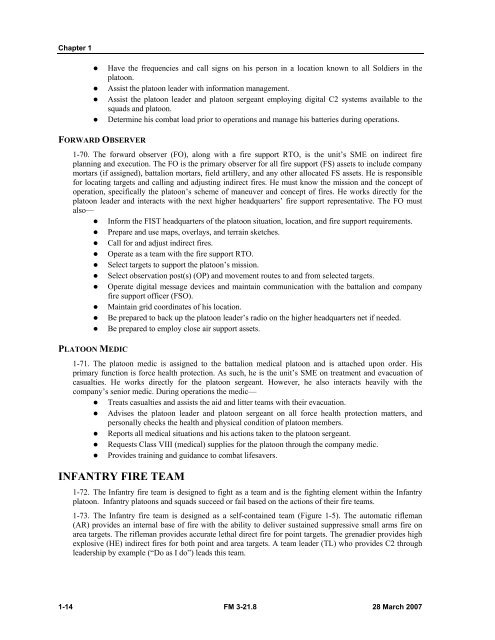Infantry Rifle Platoon and Squad - Sakai
Infantry Rifle Platoon and Squad - Sakai
Infantry Rifle Platoon and Squad - Sakai
Create successful ePaper yourself
Turn your PDF publications into a flip-book with our unique Google optimized e-Paper software.
Chapter 1<br />
• Have the frequencies <strong>and</strong> call signs on his person in a location known to all Soldiers in the<br />
platoon.<br />
• Assist the platoon leader with information management.<br />
• Assist the platoon leader <strong>and</strong> platoon sergeant employing digital C2 systems available to the<br />
squads <strong>and</strong> platoon.<br />
• Determine his combat load prior to operations <strong>and</strong> manage his batteries during operations.<br />
FORWARD OBSERVER<br />
1-70. The forward observer (FO), along with a fire support RTO, is the unit’s SME on indirect fire<br />
planning <strong>and</strong> execution. The FO is the primary observer for all fire support (FS) assets to include company<br />
mortars (if assigned), battalion mortars, field artillery, <strong>and</strong> any other allocated FS assets. He is responsible<br />
for locating targets <strong>and</strong> calling <strong>and</strong> adjusting indirect fires. He must know the mission <strong>and</strong> the concept of<br />
operation, specifically the platoon’s scheme of maneuver <strong>and</strong> concept of fires. He works directly for the<br />
platoon leader <strong>and</strong> interacts with the next higher headquarters’ fire support representative. The FO must<br />
also—<br />
• Inform the FIST headquarters of the platoon situation, location, <strong>and</strong> fire support requirements.<br />
• Prepare <strong>and</strong> use maps, overlays, <strong>and</strong> terrain sketches.<br />
• Call for <strong>and</strong> adjust indirect fires.<br />
• Operate as a team with the fire support RTO.<br />
• Select targets to support the platoon’s mission.<br />
• Select observation post(s) (OP) <strong>and</strong> movement routes to <strong>and</strong> from selected targets.<br />
• Operate digital message devices <strong>and</strong> maintain communication with the battalion <strong>and</strong> company<br />
fire support officer (FSO).<br />
• Maintain grid coordinates of his location.<br />
• Be prepared to back up the platoon leader’s radio on the higher headquarters net if needed.<br />
• Be prepared to employ close air support assets.<br />
PLATOON MEDIC<br />
1-71. The platoon medic is assigned to the battalion medical platoon <strong>and</strong> is attached upon order. His<br />
primary function is force health protection. As such, he is the unit’s SME on treatment <strong>and</strong> evacuation of<br />
casualties. He works directly for the platoon sergeant. However, he also interacts heavily with the<br />
company’s senior medic. During operations the medic—<br />
• Treats casualties <strong>and</strong> assists the aid <strong>and</strong> litter teams with their evacuation.<br />
• Advises the platoon leader <strong>and</strong> platoon sergeant on all force health protection matters, <strong>and</strong><br />
personally checks the health <strong>and</strong> physical condition of platoon members.<br />
• Reports all medical situations <strong>and</strong> his actions taken to the platoon sergeant.<br />
• Requests Class VIII (medical) supplies for the platoon through the company medic.<br />
• Provides training <strong>and</strong> guidance to combat lifesavers.<br />
INFANTRY FIRE TEAM<br />
1-72. The <strong>Infantry</strong> fire team is designed to fight as a team <strong>and</strong> is the fighting element within the <strong>Infantry</strong><br />
platoon. <strong>Infantry</strong> platoons <strong>and</strong> squads succeed or fail based on the actions of their fire teams.<br />
1-73. The <strong>Infantry</strong> fire team is designed as a self-contained team (Figure 1-5). The automatic rifleman<br />
(AR) provides an internal base of fire with the ability to deliver sustained suppressive small arms fire on<br />
area targets. The rifleman provides accurate lethal direct fire for point targets. The grenadier provides high<br />
explosive (HE) indirect fires for both point <strong>and</strong> area targets. A team leader (TL) who provides C2 through<br />
leadership by example (“Do as I do”) leads this team.<br />
1-14 FM 3-21.8 28 March 2007

















